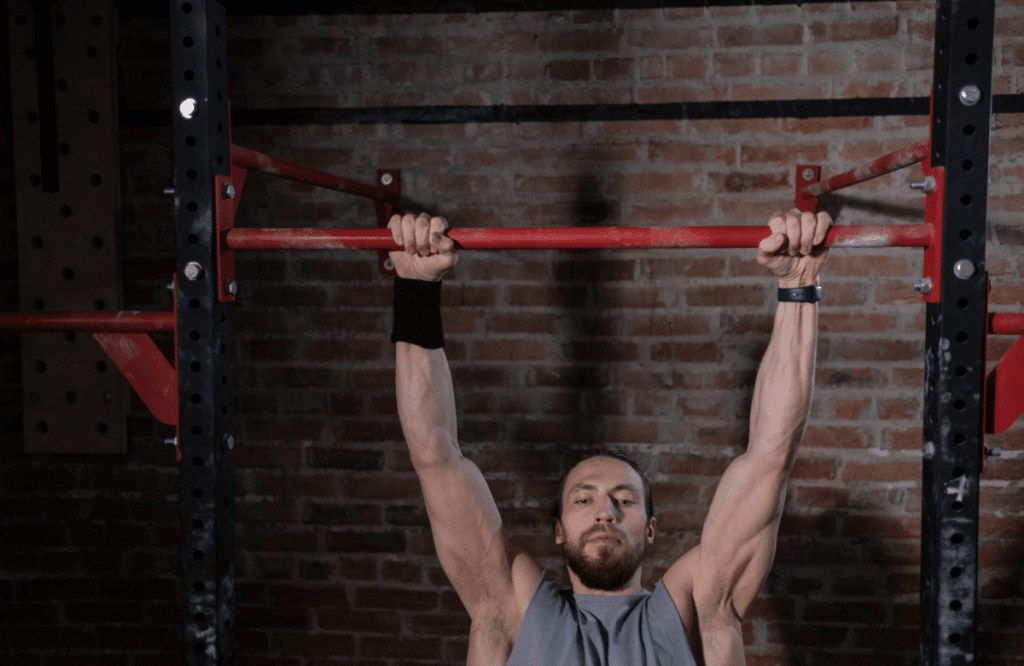Achieving a strong upper body is a worthy goal for active gym-goers. You’ve likely encountered both chin-ups and pull-ups in any workout routine meant to develop upper body strength. Both of these popular bodyweight exercises require a hanging horizontal bar that a person grips as they pull themselves up until, ideally, their chest is even with the bar.
While many get the two exercises confused because of their similarities, there are some key differences, mainly in that they target different muscle groups. Learning more about these differences and the muscles used to execute them can help you determine which exercise is best for building strength in the upper body.
Jump to:
Chin-up vs. Pull-up Explained
While chin-ups and pull-ups have many similar benefits, there are key differences. The biggest difference is found in grip variation between the two exercises. You’ll target different muscle groups when doing a chin-up compared with a pull-up. The chin-up works your biceps and pectorals while the pull-up has a greater emphasis on the back and shoulders.
How to Do a Chin-Up
To do a chin-up, use an underhand grip about shoulder-width apart on the chin-up bar. Begin in a full dead hang and activate your abdominal muscles to prevent your legs from swinging.
Squeeze your shoulder blades together and pull them down so that your shoulders are in position. Pull your elbows downward and lift your chest to the bar as high as you can go. Be careful not to shrug your shoulders or strain your neck to lift your chin to the bar.
Pause at the top before you complete the rep by slowly lowering yourself back to the starting position.
Main Benefits of a Chin-up
There are many benefits to doing this popular bodyweight exercise. Chin-ups develop muscle strength and definition in the upper back muscles and arms by targeting the biceps and lats, making it a true compound exercise.
Other than building muscle, chin-ups can also improve your grip strength and posture, as well as decrease the risk of back pain and shoulder injury.
How to Do a Pull-up
To execute a pull-up, you’ll use an overhand grip on the pull-up bar with your arms wider than shoulder-width apart. Roll your shoulders back and squeeze your shoulder blades together. Push the shoulder blades down toward your tailbone to ensure that you’re using the proper form.
Lift your feet off the floor and engage your core as you come into a full dead hang. Activate your lats, and with a full range of motion, pull yourself up until your chest is even with the bar. As you do this, bring your elbows down and in so they are tucked to the sides of your torso. Hold for a beat.
To finish the rep, lower yourself back down to the starting position with slow control.
Main Benefits of a Pull-up
The pull-up is one of the most notable exercises for strength training the upper body muscles. Pull-ups primarily target your back and shoulders as well as the upper back muscles in your posterior chain. They arguably one of the best exercises for lats.
Pull-ups are an excellent exercise for functional strength training. (This means that the arm movements required to achieve this milestone exercise are often used in everyday movements.) They can also improve grip strength and joint fluidity.
Differences in a Chin-up and a Pull-up
Many people get chin-ups and pull-ups confused, but there are some fundamental differences between the two exercises that yield unique results.
Hand Grip
The big difference between a chin-up and a pull-up is the grip variation. To do a chin-up, you use a narrower grip on the bar with your palms facing toward you and your hands in a supinated position. A pull-up has your palms facing away from you with your hands in a pronated position.
Muscles Used
There is overlap in the muscles used in a chin-up and pull-up as you begin in a similar body position and require forearm strength to pull yourself over the pull-up bar. However, the slight difference in your grip makes a big difference in which muscles are emphasized.
The primary muscles used in a chin-up are: the biceps, posterior deltoids, teres major (a shoulder muscle that helps with arm rotation), and latissimus dorsi (the largest muscle in the back that supports arm and spinal movements.)
The main muscles targeted in a pull-up are the latissimus dorsi, the trapezius muscle (specifically the middle and lower traps), and the rhomboids, a large muscle group in the upper back that helps stabilize your shoulders.

Similarities in a Chin-up and Pull-up
Both chin-ups and pull-ups are excellent compound exercises for strengthening the upper body and developing a stronger grip. They both take an impressive amount of arm strength to achieve, and as you gradually increase your reps, you’ll not only impress your gym buddies, but you’ll also notice muscle definition in your upper body.
Core Use
Both movements require you to pull yourself above a hanging horizontal bar while engaging your entire core to stabilize your body. When done properly, this movement activates the abdominal muscles, making it a great core exercise.
Weight Potential
Both pull-ups and chin-ups are bodyweight exercises, but they both have variations that could ease you into the move by supporting your weight or challenge you further by adding a weight vest or dumbbell.
Chin-up vs. Pull-up: Which Is Better?
When determining whether the chin-up or pull-up is better, the short answer is… it depends. If you’re just beginning to build up your upper body strength, you may find a chin-up to be more doable. Chin-ups allow you to rally the help of your arms and chest muscles as opposed to relying solely on your back strength to raise yourself over the bar.
Variations of a Chin-up
Whether you’re still working on building up enough strength to complete a traditional chin-up or you’re looking for a further challenge, multiple variations will meet you at your fitness level.
Band Chin-up
Using a band to assist you during a chin-up can build strength and endurance as you progress to a full bodyweight chin-up. To complete a band chin-up, make a loop at the bottom of a band and drape it over the chin-up bar. Place one knee inside the loop. This gives you an extra spring to assist you as you complete the rep.
Continue to do the rep by grabbing the bar shoulder width apart with your palms facing towards you. Engage your core and use your arms to raise your body until your chest is level with the bar. Lower yourself back to the starting position slowly and with control.
Weighted Chin-up
A weighted chin-up is a good way to add variety and progressive overload to a traditional chin-up. To execute a weighted chin-up, you’ll need a dumbbell the size of your choosing placed vertically on the floor.
Get in position as if you’re doing a traditional pull-up and secure the insides of your feet to the handle of the dumbbell. As you rise and extend over the bar, keep your legs straight with the dumbbell secure between your feet.
Engage your entire core as you keep your legs from shaking. Complete the rep by coming back down slowly.
Close Grip Chin-up
The close grip chin-up especially targets the lats but requires full body strength to execute it properly. Place your hands six to eight inches apart on a chin-up bar. Come to a dead hang with your legs pointed slightly in front of you so that your body is making somewhat of a “C” shape.
Activate your abdominals, press your thighs together, and keep your body rigid as you raise yourself above the bar. Keep your form in check by looking straight ahead. Once your neck touches the bar, pause and then slowly come back to the starting position.
Single Arm Chin-up
The single-arm chin-up is a scapular movement that requires extreme upper-body strength. It’s considered the most difficult chin-up variation and requires many months of training to execute it.
To do a single-arm chin-up, get in position by using one arm to grip the chin-up bar in an underhand grip. You’ll slowly ascend to do a chin-up using one arm in a similar motion as a bicep curl. Pause at the top before slowly returning to the starting position. Switch sides and repeat the move.
Variations of a Pull-up
Many variations and modifications to the pull-up can help increase your stamina and perfect your form as you work towards mastering the traditional pull-up.
Band Pull-up
Band pull-ups are a popular modification to the standard pull-up. This is a great exercise to add to your workout routine to develop the foundational strength that a standard pull-up requires.
You can do a band pull-up using a resistance band looped around your pull-up bar. It’s important to choose a band that assists you with the pull-up but doesn’t make it too easy, so keep that in mind if you have lighter bands. Once you’ve secured the band, you’ll put one foot in the loop of the band and place the other foot lightly on top for stability.
Grip the bar with your palms facing outwards and your arms wider than your shoulder’s width apart. Proceed to do a pull-up using the spring of the band to propel yourself up while still activating your core.
Neutral Grip Pull-up
A neutral grip pull-up (hammer pull-up) is another pull-up variation that’s a great way to shake up your upper body workout routine. To do a neutral grip pull-up, your hands will face each other in a position similar to doing a hammer curl.
You’ll need neutral handles attached to a pull-up bar to do this exercise. Grip the neutral handles with your arms about shoulder width apart and get into a free-hang position. Keep your head straight and pull yourself up until your chin is even with the bar. Keep your thighs together and your core tight. Slowly lower yourself back down to complete the rep.
Towel-Assisted Pull-up
A towel-assisted pull-up can offer support as you develop the stamina and strength to complete a one-armed pull-up. To do a towel-assisted pull-up, you’ll need a hand towel. Lay it over the pull-up bar and grip the towel with one hand. You’ll grip the pull-up bar with your other hand as if you’re doing a standard pull-up, with palms facing away from you.
The difficulty level of the pull-up increases the further down you grip the towel. This is a great exercise to help you with the form of getting your elbow pulled into your side and positioning your shoulder down and back as you extend above the bar.
Olympic Ring Pull-up
To do this exercise, you’ll need a set of Olympic rings hanging from a pull-up bar. To begin this pull-up variation, grip the center of the rings and start in the dead hang position. It’ll take full body strength as you bring your elbows in towards your sides while extending upward until your chest is level with the bottom of the rings.
You’ll find that Olympic rings are quite unsteady and require full muscle engagement, which is what makes it an incredible exercise for developing stronger abdominal muscles.
FAQs About Chin-ups vs. Pull-ups
Here are some frequently asked questions regarding chin-ups vs. pull-ups.
Are Chin-ups or Pull-ups Better for Beginners?
Chin-ups activate your bicep muscles and back muscles while pull-ups have a greater emphasis on the back muscles that make up the posterior chain. For this reason, chin-ups are often considered more beginner-friendly for those starting on their journey to stronger upper body muscles.
How Many Pull-ups Can an Average Person Do?
You’re more likely to find that average people can’t do pull-ups. However, for those dedicated to an exercise program that builds upper body strength, a normal range of reps of pull-ups for men is between 4-8 a set. A normal range for women is between 1-3 pull-ups per set.
How Many Chin-ups Can an Average Person Do?
Because chin-ups are a bodyweight exercise and everyone’s weight varies, it can be tricky to identify the average reps of chin-ups. However, a good rule of thumb for those who are in shape is between 5-7 chin-ups for men and 3-5 chin-ups for women.
Are Chin-ups and Pull-ups Equal?
Both chin-ups and pull-ups require full-body strength, and you’ll want to add both of these exercises to your strength training regimen. They work many of the same muscles, but chin-ups have a greater emphasis on the pecs and biceps while the pull-up’s primary muscle focus is on the lats and traps. They’re equally efficient at developing upper body strength and muscle gains.














